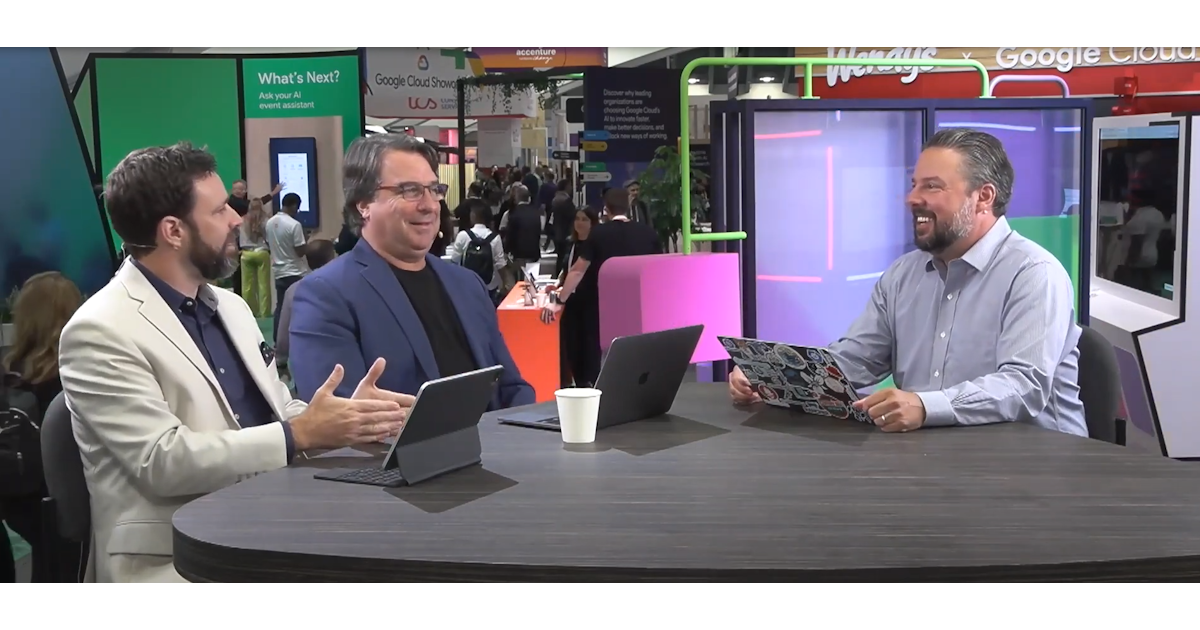 CLOUD
CLOUD
 CLOUD
CLOUD
 CLOUD
CLOUD
This week’s Google Cloud Next event in San Francisco has featured a blend of spectacle and seriousness, striking a balance between the needs of legacy systems and the aspirations of a newer, more innovative cloud ecosystem.
TheCUBE’s analyst team, John Furrier (pictured, center), Rob Strechay (right) and Dustin Kirkland (left), dissected the day 2 event keynote, as well as Google’s impact on the cloud industry.
“They’ve got a lot more work to do — they’re clearly No. 3 in the marketplace, but they are hitting all the right notes, in my opinion,” said Furrier, who also mentioned the company’s eye-catching approach to legacy systems, particularly calling out the “Living in Legacy Land” musical that kickstarted the keynote.
Strechay’s take on the keynote kickoff: “It was interesting that they were leaning into the legacy is bad kind of thing.”
For developers, especially those dealing with so-called “heritage” apps in established industries, this theatrical treatment of legacy issues must have been either amusing or disconcerting, or possibly both, he added.
During the Google Cloud Next day 2 kickoff segment, theCUBE analysts discussed how Google is engaging the developer community, addressing challenges with legacy systems and differentiating Google’s cloud offerings in a competitive market. (* Disclosure below.)
The key tension during the event, as identified by theCUBE analysts, was between Google’s focus on legacy and the more typical DevOps conversations in the cloud ecosystem.
“They didn’t really tie it, at least in my mind, effectively to the DevOps movement,” Furrier said.
Kirkland highlighted the issue succinctly: “Most developers aren’t tasked with ‘here’s a blank slate – product manager, development team — go build something new.’ Most are tasked with ‘there’s something out there running, go make it better.”
The event did not sidestep the current needs of the industry. As Kirkland observed, “Yesterday was all about here’s what’s next. Here’s what’s in beta. There was something very relatable to today’s keynote.”
This aspect of relatability is particularly essential for developers in the enterprise, where heritage or legacy apps require more than just maintenance; they demand innovation. Interestingly, the keynote also leaned into Google’s history and ethos, something that Strechay found resonant.
“That was them going back to their roots … reaching out to developers and saying … ‘The AI’s going to help you do these three layers,’” he said.
Strechay appreciated Google’s commitment to pluggability, open source and APIs, noting that this approach was like “motherhood and apple pie” for the tech giant.
Despite its showy nature, the event did not overlook the nitty-gritty of development and innovation.
“It was interesting how they showed you that there were different things under the hood happening, even though it looked like it was all in the same interface,” Strechay said.
Kirkland also spotted Google’s strength in the low-code, no-code environment, stating, “Google’s built a ton of brilliant infrastructure around that.”
However, not everyone found the keynote to be perfect. “I wanted to see more meat on the bone. I was hoping that I’d see much more stronger developer posture,” Furrier said.
This suggests that while Google made some headway in showcasing its direction and vision, there remains room for more substance. As for the broader cloud landscape, the elephant in the room was the concept of multicloud.
“There’s no multicloud talk here. You know why? Because it’s Google Cloud,” Furrier said, hinting at a future where the big cloud providers may become isolated islands of technology and influence.
What’s the key takeaway? Google Cloud Next may not have had it all, but it had enough to provoke thought, trigger debates and, most importantly, reflect the state of a cloud industry that is still trying to balance the pulls of the past and the future.
As Furrier put it, “It’s a weird time in the cloud game,” but also, perhaps, a necessary one.
Here’s the complete video interview, part of SiliconANGLE’s and theCUBE’s coverage of the Google Cloud Next event:
(* Disclosure: This is an unsponsored editorial segment. However, theCUBE is a paid media partner for Google Cloud Next. Google LLC and other sponsors of theCUBE’s event coverage do not have editorial control over content on theCUBE or SiliconANGLE.)
Support our mission to keep content open and free by engaging with theCUBE community. Join theCUBE’s Alumni Trust Network, where technology leaders connect, share intelligence and create opportunities.
Founded by tech visionaries John Furrier and Dave Vellante, SiliconANGLE Media has built a dynamic ecosystem of industry-leading digital media brands that reach 15+ million elite tech professionals. Our new proprietary theCUBE AI Video Cloud is breaking ground in audience interaction, leveraging theCUBEai.com neural network to help technology companies make data-driven decisions and stay at the forefront of industry conversations.